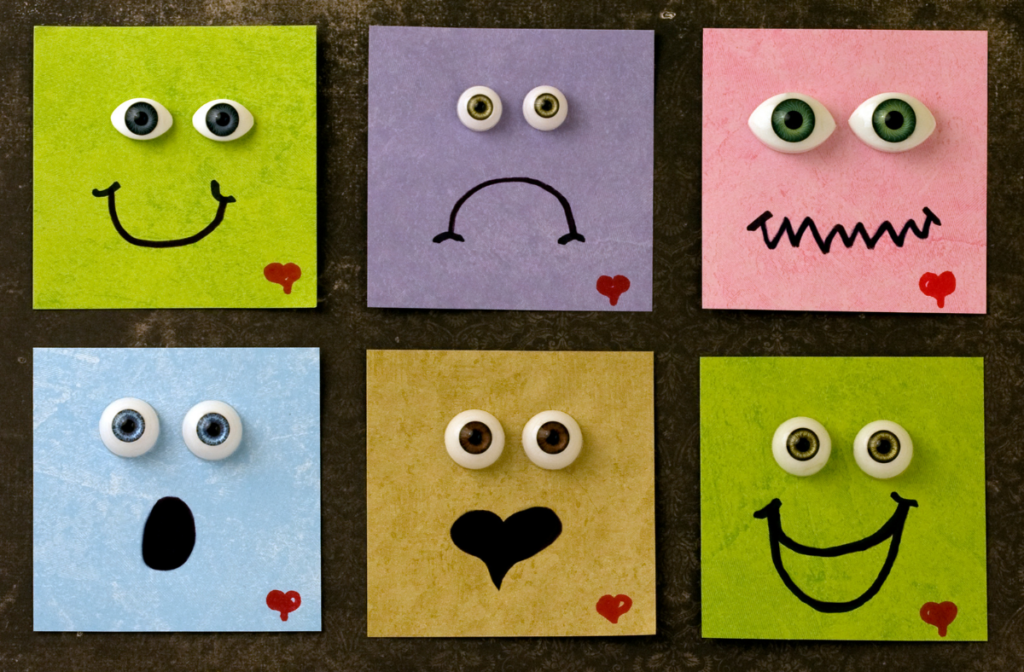There have been times in my life when I’ve been totally overwhelmed by emotions, and let me tell you, it wasn’t pretty.
But part of the reason I was so overwhelmed with emotions was that I was making myself wrong for having them by judging them as “bad”.

When I got divorced, I had been a stay-at-home mom for 13 years. Naturally, when my ex (who is a well-paid lawyer), left me, I freaked out about my financial future. Even with spousal support, my lifestyle was going to take a drastic hit.
And it did. His didn’t.
Every day I see him living the life I was living with a different partner. The hopes and dreams we had as a couple no longer belong to me – they belong to him and his husband.
I have a lot of frustration over this. I have anger and resentment. Even hatred sometimes. I thought I had moved on from those feelings, but with every new level of growth, old stuff gets triggered and we’re called to heal new layers of old wounds.
Last week, I found myself feeling all the feels about this. I was feeling incredibly sad and frustrated at how hard it is to rebuild, and I was also feeling anger and resentment toward my ex for having it so easy.
My feelings were intense.
I didn’t like it.
My first line of defense was to push those feelings away. But then, I felt bad about myself for having them in the first place. Some of the feelings scared me because they reminded me of when I was in the messy middle of healing from the divorce. (some might say I still am in the messy middle!).
The fear I had around those emotions caused me to resist them, and they spiraled to the point where I couldn’t even pinpoint where they came from.
What did I do?
I left the house. I got into my car and drove for a while. I allowed myself to cry my eyes out and wouldn’t you know it, I felt better. Not “perfect”, but a little calmer, a little more grounded and I was able to access that part of me that knew things would be ok.
But most of us these days just want to push away the difficult emotions. Do you agree?
Emotions are pretty complicated, actually, but essentially they are your brain’s best guesses of what the sensations in your body mean. These best guesses are based on past experiences, beliefs, and stories you have on autopilot in your brain.
All emotions have a purpose. Even the “negative” ones. They’re the biggest motivators of human behavior. They help us connect with others, motivate us to take action, and signal that we need something.
They are also interconnected.
Take, for example, joy and sadness. Both are two sides of the same coin, really. On one side, you might feel joy when you are doing something, or have something, you care about. On the other side, you might feel sad when you lose something you care about.
You can’t know joy without knowing sadness.
The interesting thing about emotions is that they originate with a chemical reaction in the brain. According to the website sixseconds.org, from the time the emotional chemical cocktail is released to the time it’s broken down and been absorbed by the body, is a grand total of about six seconds.
When an emotion lasts longer than that, we are, for better or worse, choosing (unconsciously) to keep fueling it or recreating it in our brain.
A final thing to note about emotions is that they are also neutral. Emotions don’t have a “positive” or “negative” until we assign them meaning.
So why do we get so overwhelmed by emotions if they are all neutral and all have a purpose?
Well, first of all, we’re human. We naturally want to move away from what feels “bad” and toward what feels “good”, and we have an innate ability to discern that without even thinking about it.
But also because of our past experiences, beliefs, and stories we have about ourselves and the way the world works. We have a bias that causes us to judge our emotions. We label them as good or bad. We assign a meaning to them.
Here’s an example of a “story” a client of mine had regarding feeling anger:
Sue found herself feeling angry after some unforeseen circumstances happened in her life. Her anger was popping up everywhere, like when someone would cut her off in traffic, or at the smallest annoyance, she felt at a customer. It was even following her home. She felt like she had a crappy attitude that was infiltrating her life. It felt very uncharacteristic for her.
Sue grew up in an environment that was chaotic and uncertain. She was the peacekeeper and being angry was a surefire recipe for erupting chaos and turmoil. Being angry caused problems. Big problems.
Naturally, Sue would feel out of sorts when she felt angry as an adult because her “anger story” said that anger is bad. Being “seen and not heard” was good.
In another person, being angry might not carry the same negative connotation, but perhaps being quiet or contemplative would be seen as a weakness.
Two different people, same emotion, different labels.
I offered to Sue that all emotions are equally valid and valuable – even the so-called “bad” ones. They all serve their own, unique purpose.

So what happens when we don’t treat our emotions with equal validity? What happens when we try to push them away?
Remember, emotions exist to motivate our behavior. They can connect us, motivate us to take action or signal a need. When we disconnect from them, we’re losing important pieces of communication within ourselves or other people. Emotions help us connect with others, and they help others understand us.
Pushing emotions away also introduces secondary emotions. For example, if you have a judgment about feeling angry, and you don’t feel like anger is an emotion that’s ok to feel, you might experience shame for feeling anger. Now, you’re not only dealing with the feelings of anger, but you’re dealing with your feelings about feeling angry too. The secondary emotion pulls you away from what your anger is trying to tell you.
Pushing your emotions away dulls your awareness of what’s important to you and causes you to lose sight of what it is you really want or need. When this happens, you’ll start to look outside of yourself for approval and validation when it comes to knowing what you want or need. You lose sight of who you really are as well.
When my client Sue and I were discussing her struggle with anger, she commented that right now she doesn’t need to feel the anger. What she really needs to feel is peace, and peace is gone. She said that when she feels anger, a part of her is gone – the part that feels peace.
The part of her that feels peace, however, is not gone.
We have equal access to all emotions at any given time. When we feel “negative” emotions, the “positive” ones are not gone. We’re just not accessing them.
We have to be willing to entertain the idea that all emotions are equal in value and we have to be willing to feel all of them. We also need to learn to trust that the feelings we’d prefer to feel are still available to us at any time, even if it’s hard to access them.
Remember also, that without the “bad”, we wouldn’t know what was “good”. This is beautifully illustrated in the movie Inside Out, where Riley’s emotion Joy tries to turn all of Riley’s sad memories into happy ones. At a pivotal point in the movie, Joy realizes Sadness’ purpose–to alert others when Riley is emotionally overwhelmed and needs help.
We need all of it. We just need to learn to trust ourselves that our emotions won’t hurt us.
I know you’re thinking that this is all great information, but how the heck do you overcome the feelings that you feel when you’re in the midst of emotional overwhelm?
First of all, I’d like to introduce the concept of impermanence.
Impermanence is a theme central to the Buddhist faith. Buddhist nun and author, Pema Chodron says “Whether we’re conscious of it or not, the ground is always shifting. Nothing lasts, including us.”
This is to say that nothing is permanent – neither the good nor the bad.
This is great news in a way. It means that the difficult emotions you experience won’t last. They come and go like waves. One intense wave rolls in, comes to a crest, and then rolls into shore, losing energy and momentum as it moves. Then there are more waves. Some bigger, some smaller. Sometimes the water is calm and sometimes it’s churning.
You just need to learn to surf the waves.

Understanding your emotions is also important. This takes being present and becoming aware of your emotions and thoughts behind them. What’s triggering your emotions? I like to ask myself, who, what, where, when, how?
Who was I with? What did they say? What happened? Where was I? When did I get triggered? Was it at a time of day when I notoriously feel tired and overwhelmed or stressed? And how did I react?
Understanding where your emotions are coming from can help you avoid spiraling down the rabbit hole with them. Taking the time to do so can help you be more rational about them and avoid magnifying the emotions or catastrophizing. (something I’m personally guilty of!)
Be willing to feel your emotions. Acknowledging and honoring them and that they’re uncomfortable, but won’t last forever, helps. Just be willing to be with them while they run their course.
Just as important is to know that it’s ok to take a break from your difficult emotions if you need to. you can do things like get some exercise, fresh air, practice breathwork, meditation or watch the clouds pass by, to name a few things.
To that end, remember that you can access more pleasant emotions at any time, so if you need to take a break from your difficult emotions, you can find a moment of calm or peace in the midst of the storm, just like Sue learned to do.
You can ask yourself how you would feel if you didn’t have to worry about whether or not your feeling was positive or negative.
In other words, what if your “negative” feeling was just as “ok” to feel as your “positive” feelings? What would be possible if they were all just neutral?
Using anger as an example, you might feel calm or relaxed if your anger didn’t have a “bad” label. Maybe you’d feel light and carefree.
What kinds of things bring the feelings of calm, lightness, and carefreeness?
This is what you can do to access those feelings when you need to. Let’s say, for example, it’s walking in nature. You can make a point to walk in nature, get present and make a point to feel those feelings of calm, carefree, and light in your body. You are accessing a part of you that feels better in the middle of the “storm”.
Just remember to allow your challenging emotions to return if they need to so you can fully process them and let them move through you. You don’t want to bypass them or push them away.
Allowing yourself to be with your feelings–all of them– is an act of self-love. By accepting those emotions, you are accepting the part of you who sometimes feels emotions that don’t feel good. In order to love yourself fully, you need to love ALL the parts of you, even the parts that are hard to love, so being with your difficult emotions and sending love and compassion to that part of you is crucial to being able to handle those emotions and trust yourself that you have your own back to get through them.
None of this work is easy, but it is possible and it’s so rewarding. The great thing about learning to be with emotions that feel overwhelming is that when you can do this, you can handle anything that comes your way.
Prefer to listen? Click HERE to listen to the accompanying podcast episode on Real, Brave, & Unstoppable!







